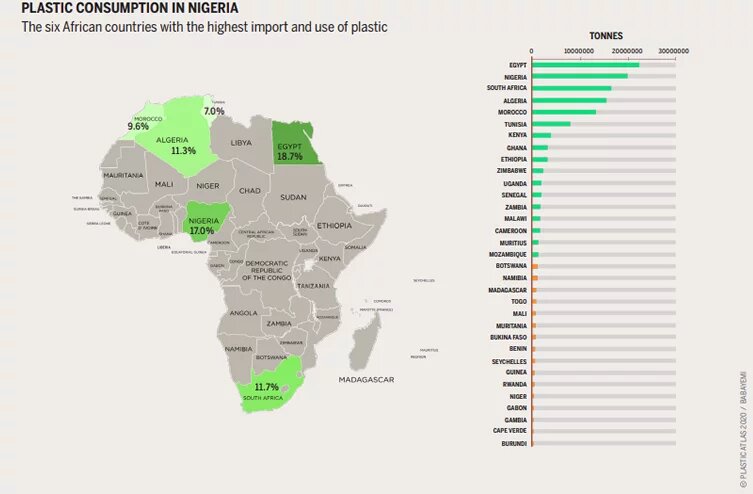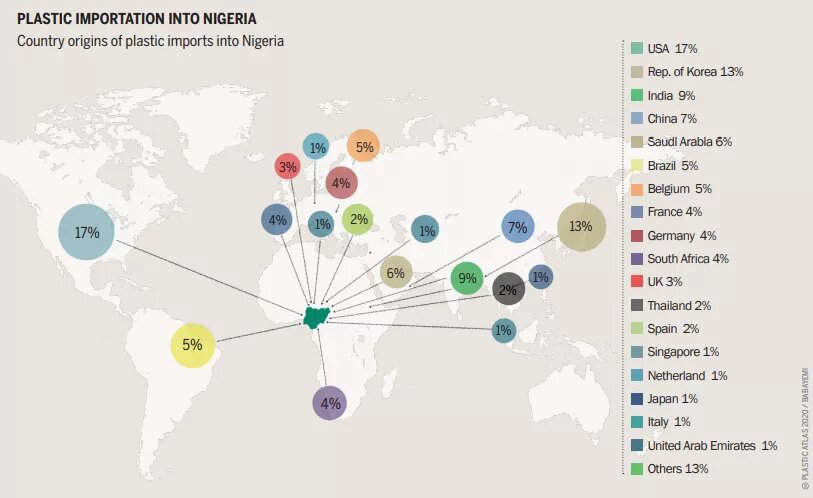
Nigeria is one of the largest consumers of plastics in Africa. With plastic use and production set to increase, the mounting effects on people and the environment can no longer be ignored.

Between 1996 and 2017, about 20 million tonnes of primary plastics and plastic products were imported into Nigeria. This makes Nigeria the second largest plastic importer in Africa and accounts for 17 percent of the total consumption of plastic on the continent. If it remains “business as usual” (i.e. no anticipated change in policy, use and waste attitude), and the volume continues to increase, it is determined that plastics importation and consumption is expected to reach a total of over 40 million tonnes by 2030. Four categories of plastics in primary form take the largest share of importation quantities in Nigeria: polyethylene, polypropylene, polyvinylchloride, and polyesters. Together, they account for about 75 percent of total plastics imported in primary form and as products. The countries that are leading the supply of these plastics into Nigeria include the United States of America (17 percent), the Republic of Korea (13 percent), and India (9 percent) among more than eighteen other countries of origin.
Nigeria also produces a considerable amount of plastic products, which is increasing at alarming levels. In 2013, there were over 3000 plastic product companies with a production capacity of over 100,000 tonnes per year. The number of companies and production capacities are expected to have more than doubled since then. Approximately 5 million tonnes of polypropylene and other olefins were imported in primary form between 1996 and 2017 to supply companies that produce plastic diapers, margarine containers, yogurt boxes, syrup bottles, rakes, plastic bottle caps, biscuit wrappers, crates, drinking straws, among others. One million tonnes of polyvinylchloride was imported as raw materials for companies producing pipes, wire and cable sheathing, synthetic leather products, shower curtains and food packaging. Another 290,000 tonnes of polystyrene was imported to produce disposable cups, plastic food boxes, insulation, egg boxes and seed trays, among other items. Other categories of plastics like amino resins, phenolics and polyurethanes are used largely in cushioning foams, thermal insulation foams and surface coatings. In addition to its plastic processing capacities, Nigeria produced 2.3 million tonnes of primary plastics between 2009 and 2015, ranking third among eight other African countries with considerable historical plastic resin production. Nigeria’s average plastic waste generation is hard to measure with estimates ranging from a low 7.5kg per capita per year up to 45kg per capita per year for cities like Lagos. What is clear from the data, however, is that consumption is rising. Already, over 850,000 tonnes of plastic wastes are mismanaged every year. Common disposal methods include dumping on landfill sites and open burning, which results in hazardous soil and air pollution as some categories of plastics contain plasticizers and flame retardants. In addition to the contamination produced by open dumpsites, the lightweight of many products such as plastic bags, styrofoam and straws makes it easy for them to be blown away from these sites thereby increasing the chances of routing them into water bodies. With other products like plastic bottles, they constitute a larger fraction of marine litter. More than 130,000 tonnes of plastic end up in Nigeria’s water bodies every year; the country is estimated to be among the top 20 countries around the world contributing to marine debris.
Less than 10 per cent of plastic waste generated is recycled. The low rate of recycling is partly explained by the fact that most categories of plastic waste are not usually sought after by recyclers. Examples include polystyrene waste, polyurethane foam, light packaging polymers or wastes of polyvinylchloride. As these products seem locally “unrecyclable”, they constitute larger fractions of plastic waste found and left on dumpsites. Despite these huge challenges with forecasts predicting an increase in plastic use and production, there are sustainable alternatives to reduce the use of plastic as illustrated by the case of Rwanda. Rwanda has shown that with the ban of plastic bags, prohibition of single-use plastics, and use of locally produced construction materials (as substitutes to imported plastic insulation), reduction in plastic consumption can be achieved alongside economic growth. Thus, a significant reduction in plastics consumption can be achieved in Africa. However, this requires not just policy reforms (bans and regulations), but also strict implementation and enforcement. The Rwandan success should be a motivation for Nigeria as this is essential in achieving sustainable consumption and production.
This is a chapter from the Plastic Atlas Nigeria.
